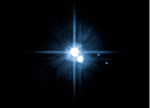Quick Links:
Sun, Moon, Mercury, Venus, Earth, Mars, Jupiter, Saturn, Uranus, Neptune, Pluto, More Planets, Comets
Pluto is a force for change that can be destructive in its power. Pluto rules Scorpio, and is exalted in Leo. Pluto is related to will, and intense passion, and has a reputation for ruthlessness. As god of the underworld Pluto brings the deepest compulsions into the light. Its position indicates areas of life that must ultimately become transformed as part of the soul's evolution.

Tiny, cold and incredibly distant, Pluto was discovered in 1930 and long considered to be the ninth planet. But after the discoveries of similar intriguing worlds even farther out, Pluto was reclassified as a dwarf planet. This new class of worlds may offer some of the best evidence of the origins of our solar system
| Planet | Mass (10x24 kg) | Volume (10x10 km3 | Equatorial radius (km) | Polar radius (km) | Mean density (kg/m3) | Surface gravity (m/s2) | Surface acceleration (m/s2) | Escape velocity (km/s) |
| Pluto | 0.0125 | 0.715 | 1195 | 1195 | 1750 | 0.58 | 0.58 | 1.2 |
| Earth | 5.9736 | 108.321 | 6378.1 | 6356.8 | 5515 | 9.80 | 9.78 | 11.2 |
| Name | Orbital Period | Sidereal rotation |
| Pluto | 247,8 Years | 6,39 Days |
Discoverer: Clyde Tombaugh
Discovery Date: 18 February 1930
Distance from Earth
Minimum (10x6 km) 4284.7
Maximum (10x6 km) 7528.0
Apparent diameter from Earth
Maximum (seconds of arc) 0.11
Minimum (seconds of arc) 0.06
Mean values at opposition from Earth
Distance from Earth (10x6 km) 5750.54
Apparent diameter (seconds of arc) 0.08
Apparent visual magnitude 15.1
Maximum apparent visual magnitude 13.65
Surface Pressure: ~3 microbar
Average temperature: ~50 K (-223 C)
Scale height: ~60 km
Mean molecular weight: ~16-25 g/mole
Atmospheric composition: Methane (CH4), Nitrogen (N2)
Technical Information courtesy of Nasa
Quick Links:
Sun, Moon, Mercury, Venus, Earth, Mars, Jupiter, Saturn, Uranus, Neptune, Pluto, More Planets, Comets